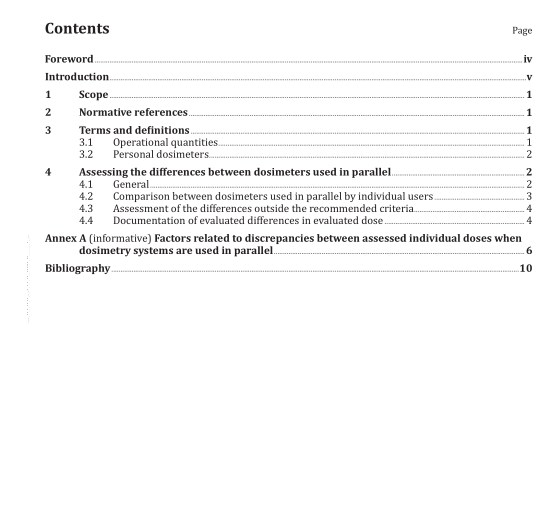ISO 15690:2013 pdf download.Radiological protection — Recommendations for dealing with discrepancies between personal dosimeter systems used in parallel
This International Standard provides recommendations for dealing with discrepancies between dosimeter systems used in parallel, in order to comply with established criteria and national regulations. This International Standard gives guidelines for investigating and analysing the discrepancies between the results of personal dosimetry systems, using two or more dosimeters (often one passive dosimeter and one active dosimeter), worn in parallel by the same worker.
This International Standard identifies when the difference between measurements made by personal dosimetry systems used in parallel is considered significant and, hence, needs to be investigated. It specifies the treatment of this difference. In this International Standard, only the personal dose equivalent, H p (10), from photon radiation is considered. Exposure to beta particles and neutrons might need to be taken into account when identified discrepancies are investigated. This International Standard applies to situations where the period of wearing can be integrated to the same period of time for both systems.
2 Normative references
The following referenced documents are indispensable for the application of this document. For dated references, only the edition cited applies.
For undated references, the latest edition of the referenced document (including any amendments) applies. ISO 14146, Radiation protection
— Criteria and performance limits for the periodic evaluation of processors of personal dosemeters for X and gamma radiation
IEC 61526, Measurement of personal dose equivalents Hp(10) and Hp(0,07) for X, gamma, neutron and beta radiations
— Direct reading personal dose equivalent meters IEC 62387, Radiation protection instrumentation
— Passive integrating dosimetry systems for personal and environmental monitoring of photon and beta radiation
3 Terms and definitions
For the purposes of this document, the following terms and definitions apply.
3.1 Operational quantities
3.1.1 personal dose equivalent H p (d) dose equivalent in soft tissue measured at an appropriate depth, d, below a specified point of the body Note 1 to entry: For strongly penetrating radiation, a depth of 10 mm is frequently recommended. For weakly penetrating radiation, a depth of 3 mm for the lens of the eye and 0,07 mm for the skin are employed. For these purposes, H p (d) is written as H p (10), H p (3), and H p (0,07), respectively.
Note 2 to entry: This definition ensures that the personal dose equivalent, H p (10), for a whole-body exposure to strongly penetrating radiation, represents an estimate of the effective dose and the equivalent dose for deep- lying organs. Note 3 to entry: In many instances, the angular distribution needs to be considered for these situations. The personal dose equivalent is defined as H p (d,α), where α represents the angle of incidence. Note 4 to entry: H p (d,α) cannot be directly measured. It is approximated using an ICRU slab phantom.
3.2 Personal dosimeters
3.2.1 approved dosimeter personal dosimeter used to determine the personal dose equivalent and issued by a measurement office in compliance with national regulations
Note 1 to entry: In some countries, the approved dosimeters are named legal, official, or accredited dosimeters.
Note 2 to entry: When more than one approved dosimeter is used at the same time for one person, only one of the measured doses should be considered to be the technical basis used for the recorded personal dose equivalent. This choice of using measurements from one approved dosimeter for official (legal) purposes should be documented.
3.2.2 passive integrating dosimeter personal dosimeter that utilises one or more detectors to integrate information about the absorbed energy and needs a readout unit to display the information
Note 1 to entry: The integration time is usually one month. The latent signal needs to be assessed by a competent dosimetry laboratory to determine the personal dose equivalent at the end of a wear period and to enter the personal dose equivalent into dose registers. National legislation/decisions can allow for integrating times other than one month.
3.2.3 active integrating dosimeter personal dosimeter that utilises one or more detectors to integrate information about the absorbed energy and to convert and display this as H p (d)
Note 1 to entry: The integration time is usually as short as a one entry period into controlled areas. These detectors normally give a direct reading of the personal dose equivalent. Alarms can warn the worker when preset dose or dose rate levels are exceeded. They are normally connected to electronic readout units at exit from controlled areas. The output is used to assess the personal dose equivalent and entered into computers with dose registers.ISO 15690 pdf download.ISO 15690-2013 pdf download
